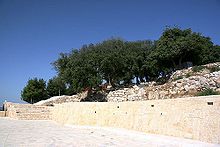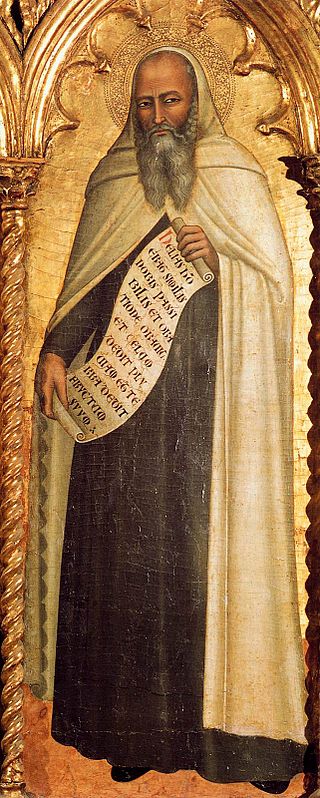
Elijah was, according to the Books of Kings in the Hebrew Bible, a prophet and a miracle worker who lived in the northern kingdom of Israel during the reign of King Ahab. In 1 Kings 18, Elijah defended the worship of the Hebrew God over that of the Canaanite deity Baal. God also performed many miracles through Elijah, including resurrection, bringing fire down from the sky, and entering heaven alive "by fire". He is also portrayed as leading a school of prophets known as "the sons of the prophets". Following his ascension, Elisha, his disciple and most devoted assistant, took over his role as leader of this school. The Book of Malachi prophesies Elijah's return "before the coming of the great and terrible day of the LORD", making him a harbinger of the Messiah and of the eschaton in various faiths that revere the Hebrew Bible. References to Elijah appear in Sirach, the New Testament, the Mishnah and Talmud, the Quran, the Book of Mormon, and Baháʼí writings.

A mosaic is a pattern or image made of small regular or irregular pieces of colored stone, glass or ceramic, held in place by plaster/mortar, and covering a surface. Mosaics are often used as floor and wall decoration, and were particularly popular in the Ancient Roman world.

Mount Nebo is an elevated ridge located in Jordan, approximately 700 metres (2,300 ft) above sea level. Part of the Abarim mountain range, Mount Nebo is mentioned in the Bible as the place where Moses was granted a view of the Promised Land before his death. The view from the summit provides a panorama of the West Bank across the Jordan River valley. The city of Jericho is usually visible from the summit, as is Jerusalem on a very clear day. The biblical town of Nebo, now known as Khirbet al-Mukhayyat, is located 3.5 km away.
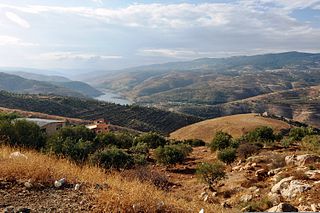
Gilead or Gilad is the ancient, historic, biblical name of the mountainous northern part of the region of Transjordan. The region is bounded in the west by the Jordan River, in the north by the deep ravine of the river Yarmouk and the region of Bashan, and in the southwest by what were known during antiquity as the “plains of Moab”, with no definite boundary to the east. In some cases, “Gilead” is used in the Bible to refer to all the region east of the Jordan River. Gilead is situated in modern-day Jordan, corresponding roughly to the Irbid, Ajloun, Jerash and Balqa Governorates.

Ajloun, also spelled Ajlun, is the capital town of the Ajloun Governorate, a hilly town in the north of Jordan, located 76 kilometers north west of Amman. It is noted for its impressive ruins of the 12th-century Ajloun Castle.
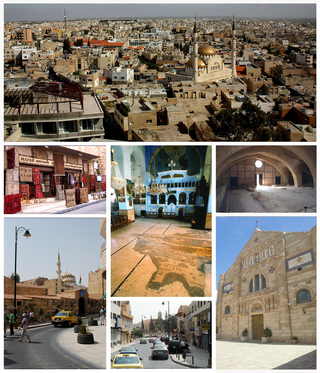
Madaba is the capital city of Madaba Governorate in central Jordan, with a population of about 60,000. It is best known for its Byzantine and Umayyad mosaics, especially a large Byzantine-era mosaic map of the Holy Land. Madaba is located 30 kilometres south-west of the capital Amman.
Tishbe, sometimes transliterated as Thisbe, is a town mentioned in the Hebrew Bible's First Book of Kings, 1 Kings 17:1, as the residence and possibly even birthplace of the Prophet Elijah, known as the Tishbite. It is placed by the biblical text in the historical region of Gilead, now in the western part of modern-day Jordan. However, the toponym may denominate another location, as discussed below.

Umm ar-Rasas, ancient name: Kastron Mefa'a, is located 30 km southeast of Madaba in the Amman Governorate in central Jordan. It was once accessible by branches of the King's Highway, and is situated in the semi-arid steppe region of the Jordanian Desert. The site has been associated with the biblical settlement of Mephaat mentioned in the Book of Jeremiah. The Roman military utilized the site as a strategic garrison, but it was later converted and inhabited by Christian and Islamic communities. In 2004, the site was inscribed as a UNESCO World Heritage Site, and is valued by archaeologists for its extensive ruins dating to the Roman, Byzantine, and early Muslim periods. The Franciscan academic society in Jerusalem, Studium Biblicum Franciscanum (SBF), carried out excavations at the north end of the site in 1986, but much of the area remains buried under debris.

Madaba is one of the governorates of Jordan. It is located southwest of Amman, the capital of Jordan, and its capital is Madaba. The governorate is ranked 8th by population and by area. It is bordered by Balqa Governorate to the north, The Capital Governorate to the east, Karak Governorate to the south and the Dead Sea to the west.
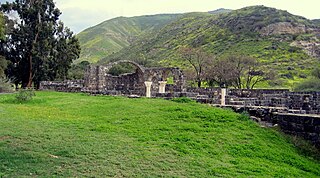
Kursi is an archaeological site in the Golan Heights containing the ruins of a Byzantine monastery and identified by tradition as the site of Jesus' "Miracle of the Swine". Part of the archaeological site is now an Israeli national park. Kursi takes its name from the Talmudic site. A marble slab with Aramaic text discovered in December 2015 seems to indicate that the settlement had, as of ca. 500 CE, a Jewish or Judeo-Christian population.
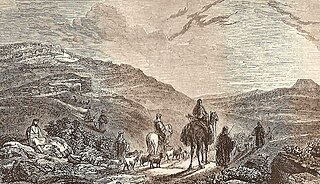
Teqoa is a Palestinian town in the Bethlehem Governorate, located 12 km (7.5 mi) southeast of Bethlehem in the West Bank. The town is built adjacent to the biblical site of Tekoa (Thecoe), now Khirbet Tuqu’, from which it takes its name. Today's town includes three other localities: Khirbet Ad Deir, Al Halkoom, and Khirbet Teqoa. According to the Palestinian Central Bureau of Statistics (PCBS), Teqoa had a population of 8,881 in 2007.

The Stella Maris Monastery is a Catholic Christian monastery for Discalced Carmelite monks, located on the slopes of Mount Carmel in Haifa, Israel.

Early Byzantine mosaics in the Middle East are a group of Christian mosaics created between the 4th and the 8th centuries in ancient Syria, Palestine and Egypt when the area belonged to the Byzantine Empire. The eastern provinces of the Eastern Roman Empire and its continuation, the Byzantine Empire, inherited a strong artistic tradition from pagan Late Antiquity. The tradition of making mosaics was carried on in the Umayyad era until the end of the 8th century. The great majority of these works of art were later destroyed but archeological excavations unearthed many surviving examples.

The Church of the Transfiguration is a Franciscan church located on Mount Tabor in Israel. It is traditionally believed to be the site where the Transfiguration of Jesus took place, an event in the Gospels in which Jesus is transfigured upon an unnamed mountain and speaks with Moses and Elijah.

Al Hashimiyya is a village in the Ajloun Governorate of north-western Jordan. The village is located 7 km northwest of Ajloun, 22 km south of Irbid and 108 km north of Amman. It is near Ajloun Castle and Tell Mar Elias. The largest tribes are Bani 'Ata, Qwaqnah (قواقنة), Gharaibeh (غرايبة), Rababah (ربابعة), Za'areer (زعارير), Abu Sini and Haddad (حداد). Hashimiyya is one of the three villages that are part of the Ash Shefa Municipality along with Halawah (حلاوة) and Al Wahadinah (الوهادنه).

Al Wahadinah (الوهادنه), Khirbet Mar Elias or Khirbet al Wahadneh is a village in the Ajloun Governorate, Jordan. Along with Al Hashimiyya and Halawah, it makes up the Ash Shefa Municipality. It has a large Christian population and contains both a Catholic and an Eastern Orthodox church.

Al-Maghtas, officially known as Baptism Site "Bethany Beyond the Jordan", is an archaeological World Heritage site in Jordan, on the east bank of the Jordan River, considered to be the original location of the Baptism of Jesus by John the Baptist and venerated as such since at least the Byzantine period. The place has also been referred to as Bethabara and historically Bethany.
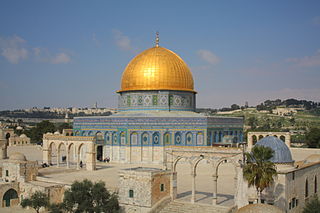
Umayyad architecture developed in the Umayyad Caliphate between 661 and 750, primarily in its heartlands of Syria and Palestine. It drew extensively on the architecture of older Middle Eastern and Mediterranean civilizations including the Sassanian Empire and Byzantine Empire, but introduced innovations in decoration and form. Under Umayyad patronage, Islamic architecture began to mature and acquire traditions of its own, such as the introduction of mihrabs to mosques, a trend towards aniconism in decoration, and a greater sense of scale and monumentality compared to previous Islamic buildings. The most important examples of Umayyad architecture are concentrated in the capital of Damascus and the Greater Syria region, including the Dome of the Rock, the Great Mosque of Damascus, and secular buildings such as the Mshatta Palace and Qusayr 'Amra.

1 Kings 17 is the seventeenth chapter of the Books of Kings in the Hebrew Bible or the First Book of Kings in the Old Testament of the Christian Bible. The book is a compilation of various annals recording the acts of the kings of Israel and Judah by a Deuteronomic compiler in the seventh century BCE, with a supplement added in the sixth century BCE. This chapter belongs to the section comprising 1 Kings 16:15 to 2 Kings 8:29 which documents the period of Omri's dynasty. The focus of this chapter is the activity of prophet Elijah during the reign of king Ahab in the northern kingdom.
